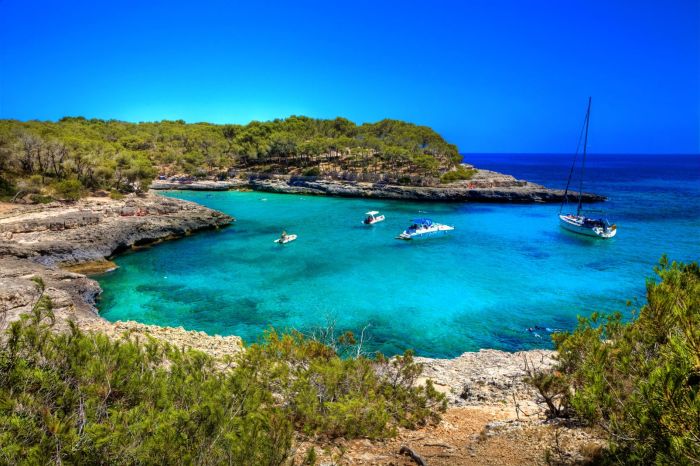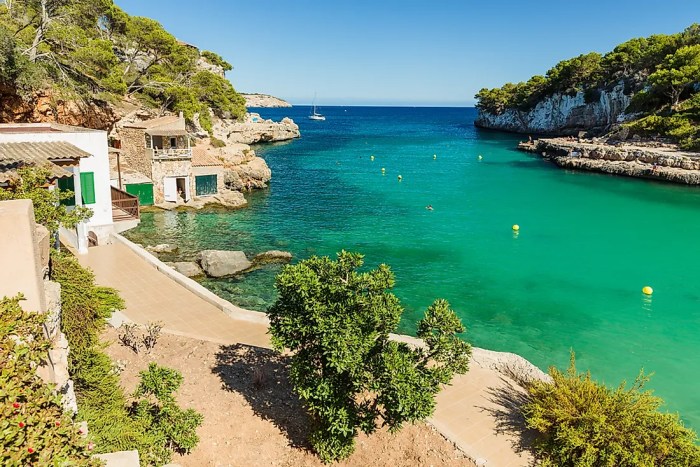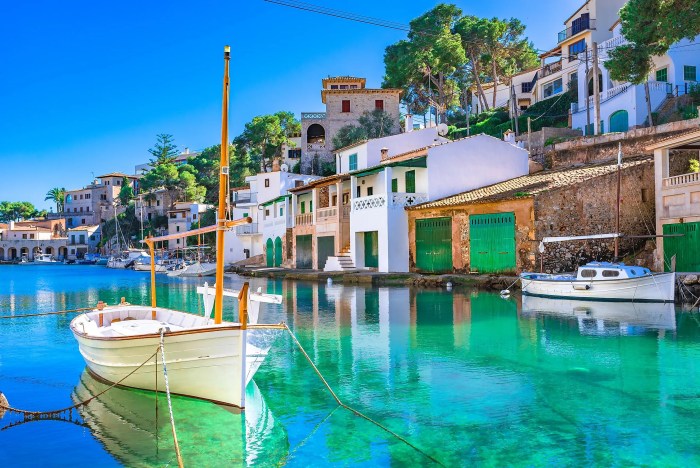Unveiling the enchanting Balearic Islands, this comprehensive guide invites you on a journey through their rich tapestry of history, captivating landscapes, and vibrant culture. From ancient origins to a modern-day haven for travelers, these islands beckon with a charm that is both timeless and alluring.
Nestled in the heart of the Mediterranean Sea, the Balearic Islands boast a captivating blend of natural wonders and cultural treasures. Discover the secrets of these idyllic shores, where pristine beaches meet crystal-clear waters, and ancient traditions intertwine with modern influences.
History and Culture

The Balearic Islands boast a rich and diverse history, dating back to the ancient times. The islands were first inhabited by the Talayotic people, who left behind numerous archaeological remains, including the iconic talayots, which are megalithic structures.
In the 3rd century BC, the islands were conquered by the Carthaginians, followed by the Romans in the 1st century BC. The Roman Empire had a profound impact on the islands, introducing Christianity and Latin, which evolved into the local Catalan language. After the fall of the Roman Empire, the Balearic Islands were ruled by the Vandals and then the Byzantines.
Medieval Period
During the Middle Ages, the Balearic Islands were conquered by the Moors in the 10th century. The Moorish period left a significant imprint on the islands’ culture and architecture, particularly in the city of Palma de Mallorca.
In the 13th century, the islands were reconquered by the Christian forces led by King James I of Aragon. The Christian conquest marked a new era in the history of the Balearic Islands, as they became part of the Kingdom of Aragon and later the Spanish Empire.
Modern Period
In the 18th century, the Balearic Islands experienced a period of economic and cultural growth. The islands became an important center for trade and commerce, and the city of Palma de Mallorca flourished as a cultural hub.
In the 19th century, the Balearic Islands became a popular destination for tourists, particularly from the British Isles. The islands’ mild climate, beautiful beaches, and rich history attracted visitors from all over Europe.
The Balearic Islands, with their stunning beaches and vibrant culture, are a popular destination for travelers. One of the best ways to get to the islands is by azores airlines , which offers direct flights from several major cities. With its convenient flight schedules and comfortable cabins, azores airlines makes it easy to explore the beauty of the Balearic Islands.
Today, the Balearic Islands are a thriving tourist destination, known for their beautiful beaches, stunning landscapes, and rich cultural heritage.
Geography and Nature

The Balearic Islands, an archipelago in the western Mediterranean Sea, are a captivating destination known for their idyllic landscapes and diverse ecosystems. The islands, nestled between the Spanish mainland and the North African coast, bask in a temperate climate with mild winters and warm summers.
Location and Topography
The Balearic Islands consist of four main islands: Mallorca, Menorca, Ibiza, and Formentera. Mallorca, the largest and most populous island, is characterized by its mountainous interior, with the Serra de Tramuntana reaching heights of over 1,400 meters. Menorca, the second-largest island, is known for its gentle rolling hills and pristine coastline. Ibiza, the third-largest island, is renowned for its vibrant nightlife and stunning beaches. Formentera, the smallest and most isolated island, boasts some of the most beautiful beaches in the Mediterranean.
Natural Beauty
The Balearic Islands are a haven for nature lovers. The crystal-clear waters of the Mediterranean Sea, teeming with marine life, invite swimmers, snorkelers, and divers to explore its underwater wonders. The islands’ coastlines are dotted with pristine beaches, from the white sands of Playa de Ses Illetes in Formentera to the secluded coves of Cala Galdana in Menorca. The interiors of the islands offer a contrasting landscape, with lush forests, rugged mountains, and tranquil valleys.
Tourism and Recreation

The Balearic Islands, renowned for their stunning landscapes, azure waters, and rich history, are a popular tourist destination. The islands attract a diverse range of visitors, from sun-seekers and beach enthusiasts to nature lovers and adventure seekers.
Major Attractions
- Picturesque Beaches: The Balearic Islands boast some of the most beautiful beaches in the Mediterranean, with pristine sands, crystal-clear waters, and secluded coves.
- Historical Sites: The islands have a rich cultural heritage, with ancient ruins, medieval castles, and charming old towns.
- Natural Beauty: The islands offer a diverse range of natural landscapes, from rugged cliffs and lush forests to tranquil bays and shimmering salt lakes.
Target Audience
The Balearic Islands cater to a wide range of tourists, including:
- Families: The islands offer a safe and family-friendly environment, with numerous child-friendly attractions and activities.
- Couples: The romantic atmosphere and secluded beaches make the islands an ideal destination for couples.
- Young Adults: The islands’ vibrant nightlife and party scene attract young adults from around the world.
- Nature Enthusiasts: The islands’ diverse landscapes and protected natural areas offer ample opportunities for hiking, cycling, and birdwatching.
Economic Impact
Tourism is a vital part of the Balearic Islands’ economy. It generates employment, supports local businesses, and contributes significantly to the islands’ GDP.
Recreational Activities
Beyond its stunning beaches and historical attractions, the Balearic Islands offer a wide range of recreational activities:
- Water Sports: The islands’ clear waters are ideal for swimming, snorkeling, diving, and sailing.
- Hiking and Cycling: The islands’ varied terrain offers numerous trails for hiking and cycling, ranging from gentle paths to challenging mountain climbs.
- Golf: The islands have several world-class golf courses, attracting golf enthusiasts from around the world.
- Horse Riding: The islands’ picturesque countryside provides a beautiful setting for horse riding.
Economy and Infrastructure

The Balearic Islands boast a thriving economy driven by tourism, which accounts for over 80% of its GDP. The islands are renowned for their stunning beaches, crystal-clear waters, and vibrant nightlife, attracting millions of visitors each year.
Other key industries include agriculture, construction, and manufacturing. The islands produce a variety of agricultural products, including almonds, olives, and wine. The construction industry is fueled by the demand for new hotels and resorts, while the manufacturing sector produces a range of goods, including textiles, ceramics, and machinery.
Infrastructure
The Balearic Islands have a well-developed infrastructure that supports both tourism and local residents. The islands are connected to mainland Spain and other European destinations by air and sea. There is an extensive network of roads and highways that link the different parts of the islands.
The islands also have a comprehensive healthcare system that provides high-quality medical care to residents and visitors. There are several hospitals and clinics located throughout the islands, as well as a network of pharmacies and medical centers.
Education is another important aspect of the infrastructure of the Balearic Islands. There are a number of public and private schools on the islands, offering a wide range of educational opportunities for students of all ages. The University of the Balearic Islands is the main higher education institution on the islands, offering a variety of undergraduate and graduate programs.
Balearic Islands are a group of Spanish islands in the Mediterranean Sea, popular for their stunning beaches and vibrant nightlife. Just like the charming medieval town of Bergamo in northern Italy, the Balearic Islands offer a captivating blend of history, culture, and natural beauty, making them a perfect destination for travelers seeking a rich and unforgettable experience.
Art and Architecture: Balearic Islands
The Balearic Islands boast a vibrant art and architectural scene that showcases the islands’ rich cultural heritage and modern influences. From the ancient ruins of Roman settlements to the contemporary masterpieces of local artists, the Balearics offer a diverse range of artistic experiences.
The Balearic Islands, an archipelago in the Mediterranean Sea, offer a captivating blend of sun-kissed beaches, rugged coastlines, and vibrant culture. While exploring the Balearics, consider venturing to Belize City , a bustling metropolis on the Caribbean coast. After immersing yourself in the vibrant atmosphere of Belize City, return to the Balearics to continue your exploration of this enchanting archipelago, where hidden coves and picturesque villages await your discovery.
The islands have a long history of artistic expression, dating back to the prehistoric era. The Talayotic culture, which flourished in the Balearics from around 1500 to 1200 BCE, left behind impressive megalithic structures, including the Naveta d’Es Tudons on Menorca. These ancient monuments showcase the advanced architectural skills of the Talayotic people.
Architectural Landmarks
The Balearic Islands are home to a wealth of architectural landmarks that reflect the islands’ diverse cultural influences. The Gothic Cathedral of Palma de Mallorca, with its soaring spires and intricate stained-glass windows, is a testament to the island’s medieval heritage. The modernist buildings of Antoni Gaudí, such as the Casa Batlló in Palma de Mallorca, showcase the islands’ connection to the Art Nouveau movement.
Contemporary Art
The Balearic Islands are also home to a thriving contemporary art scene. Galleries in Palma de Mallorca, Ibiza, and Menorca showcase the work of local and international artists. The Es Baluard Museu d’Art Contemporani de Palma de Mallorca is a must-visit for art enthusiasts, featuring a diverse collection of contemporary art from the Balearics and beyond.
Food and Cuisine
The Balearic Islands are renowned for their delectable cuisine, a harmonious blend of traditional flavors and contemporary culinary innovations. The islands’ proximity to the Mediterranean Sea has profoundly influenced their gastronomy, with fresh seafood and local produce forming the foundation of many dishes.
Traditional Balearic cuisine emphasizes simplicity and freshness, showcasing the natural flavors of local ingredients. One of the most iconic dishes is paella, a saffron-infused rice dish cooked with seafood, vegetables, and meat. Sobrasada, a spicy cured sausage, is another local delicacy, often served with bread or crackers.
Local Ingredients, Balearic islands
The Balearic Islands are blessed with an abundance of fresh produce, including fruits, vegetables, and herbs. Almonds, figs, and olives are among the most common ingredients used in local cuisine. The islands’ unique microclimate also allows for the cultivation of citrus fruits, such as oranges and lemons, which add a vibrant flavor to many dishes.
Culinary Traditions
Traditional Balearic culinary practices have been passed down through generations. One notable tradition is the use of sofrito, a flavorful base made from sautéed onions, garlic, and tomatoes. Sofrito forms the foundation of many dishes, including stews, soups, and sauces.
Mediterranean and International Influences
Over the centuries, the Balearic Islands have been influenced by various Mediterranean and international cuisines. Italian, French, and North African flavors have all left their mark on the islands’ gastronomy. This cross-cultural exchange has resulted in a diverse culinary landscape that offers a wide range of dishes to suit all palates.
Sustainability and Environmental Conservation

The Balearic Islands face environmental challenges such as climate change, water scarcity, and pollution. To address these issues, the islands have implemented various sustainability initiatives. These include promoting renewable energy, reducing waste, and protecting marine ecosystems.
Sustainable Tourism
The Balearic Islands are a popular tourist destination, and the tourism industry has a significant impact on the environment. To mitigate this impact, the islands have adopted sustainable tourism practices, such as:
– Promoting low-carbon transportation options, such as cycling and public transportation.
– Encouraging tourists to stay in eco-friendly accommodations.
– Raising awareness about the importance of respecting the natural environment.
Closing Summary
As we bid farewell to the enchanting Balearic Islands, their allure lingers, leaving an indelible mark on our hearts and minds. From the vibrant streets of Palma to the tranquil coves of Menorca, these islands have woven a spell that continues to enchant. Whether seeking historical exploration, natural escapades, or cultural immersion, the Balearic Islands offer an unforgettable experience that will forever hold a special place in your memories.
Frequently Asked Questions
What is the best time to visit the Balearic Islands?
The best time to visit the Balearic Islands is during the shoulder seasons (April-May and September-October) when the weather is pleasant, and the crowds are smaller.
What are the must-see attractions in the Balearic Islands?
Some of the must-see attractions in the Balearic Islands include the Cathedral of Palma de Mallorca, the beaches of Formentera, the historic city of Ibiza, and the Tramuntana Mountains.
What is the local cuisine like in the Balearic Islands?
The local cuisine in the Balearic Islands is a blend of Mediterranean and Spanish flavors. Some of the popular dishes include paella, sobrasada, and ensaimada.